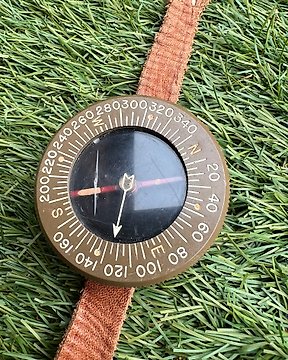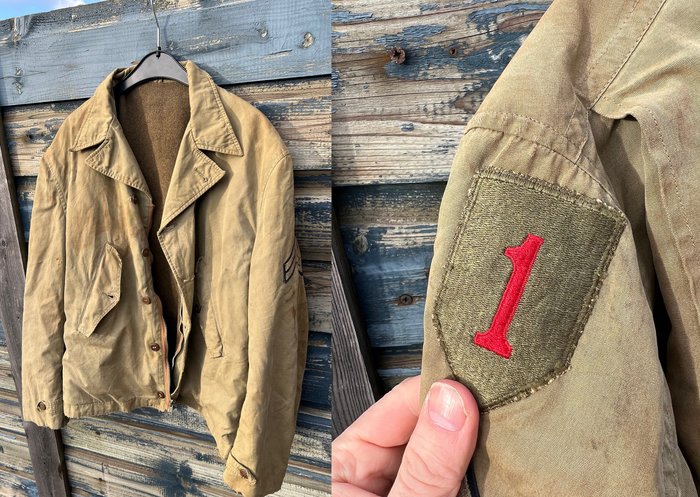
Amerikas Forenede Stater - WW2 Faldskærmstropper stil håndled Kompas - båret af faldskærmstropper, ingeniører - med rem, - Militærudstyr - 1944
Nr. 65452809

Nr. 65452809

Offered for auction is a rare very nice, combat-worn M-1941 uniform jacket, with an original applied 1st Infantry Division ''The Big Red One patch. The jacket is complete with functional zip (marked Talon, so the original zippers!_ and buttons, and also has the label, although it has been washed out (however, these jackets are always WW2, they were replaced in 1943). A really nice combat-used jacket that you dont see often for sale, of a very famous US division that saw a lot of combat. Please see all the attached photo's for an own important impression of the condition of the jacket - all 100% original, a rare find.
Great and rare 100% original rare M-41 combat jacket!
History of the 1st Infantry Division and M-1941 combat uniform
As part of II Corps, the division landed in Oran, Algeria on 8 November 1942 as part of Operation Torch, the Allied invasion of French North Africa.[15] Elements of the division then took part in combat at Maktar, Tebourba, Medjez el Bab, the Battle of Kasserine Pass (where American forces were pushed back), and Gafsa. It then led the Allied assault in brutal fighting at El Guettar, Béja, and Mateur. The 1st Infantry Division was in combat in the Tunisian Campaign from 21 January 1943 to 9 May 1943, helping secure Tunisia. The campaign ended just days later, with the surrender of almost 250,000 Axis soldiers. After months of nearly continuous fighting, the division had a short rest before training for the next operation.
In July 1943, the division took part in the Allied invasion of Sicily, codenamed Operation Husky, still under the command of Major General Allen. Lieutenant General George S. Patton, commanding the U.S. Seventh Army, specifically requested the division as part of his forces for the invasion of Sicily. It was still assigned to the II Corps. In Sicily the 1st Division saw heavy action when making amphibious landings opposed by Italian and German tanks at the Battle of Gela. The 1st Division then moved up through the center of Sicily, slogging it out through the mountains along with the 45th Infantry Division. In these mountains, the division saw some of the heaviest fighting in the entire Sicilian campaign at the Battle of Troina; some units losing more than half their strength in assaulting the mountain town. On 7 August 1943, Major General Allen was relieved of his command by Lieutenant General Omar Bradley, then commanding the II Corps. Allen was replaced by Major General Clarence R. Huebner who was, like Allen, a decorated veteran of World War I who had served with the 1st Infantry Division throughout the war.
When that campaign was over, the division returned to England, arriving there on 5 November 1943[14]: 622 to prepare for the eventual invasion of Normandy.[6] One regimental combat team of 1st Infantry Division and one regimental combat team from the 29th Infantry Division as well as A,B,C companies of the 2nd Rangers Battalion and the 5th Rangers Battalion comprised the first wave of troops that assaulted German Army defenses on Omaha Beach on D-Day.[6][16] The division had to run 300 yards to get to the bluffs, with some of the division's units suffering 30 percent casualties in the first hour of the assault,[17] and secured Formigny and Caumont in the beachhead by the end of the day. The division followed up the Saint-Lô break-through with an attack on Marigny, 27 July 1944.
The division then drove across France in a continuous offensive. It took large numbers of prisoners during the Battle of the Mons Pocket, and reached the German border at Aachen in September. The division laid siege to Aachen, taking the city after a direct assault on 21 October 1944.[6] The 1st Division then attacked east of Aachen through the Hürtgen Forest, driving to the Ruhr, and was moved to a rear area 7 December 1944 for refitting and rest following 6 months of combat. When the German Wacht Am Rhein offensive (commonly called the Battle of the Bulge) was launched on 16 December 1944,[6] the division, now commanded by Major General Clift Andrus, was quickly moved to the Ardennes front. Fighting continuously from 17 December 1944 to 28 January 1945, the division helped to blunt and reverse the German offensive. Thereupon, the division, now commanded by Major General Clift Andrus, attacked and again breached the Siegfried Line, fought across the Ruhr, 23 February 1945, and drove on to the Rhine, crossing at the Remagen bridgehead, 15–16 March. The division broke out of the bridgehead, took part in the encirclement of the Ruhr Pocket, captured Paderborn, pushed through the Harz Mountains, and was in Czechoslovakia, fighting at Kynšperk nad Ohří, Prameny, and Mnichov (Domažlice District) when the war in Europe ended. Sixteen members of the division were awarded the Medal of Honor during World War II.
The Jacket, Field, O.D. (also unofficially known as O.D. Cotton Field Jacket, Parsons Jacket, or M1941) is a field jacket that was used by US Army soldiers, most famously during the beginning of World War II. In 1941 it started to be phased in as a replacement for the wool four-pocket service coat of World War I, but around 1943 it was replaced in turn by the improved M1943 model. Owing to wide adoption, the M1941 is usually recognized as a symbol of the World War II American G.I. The jacket was made in a light shade of olive drab called O.D. number 2.
When the US entered the war in 1941, the O.D. cotton field jacket was the standard outer garment for all army personnel, except those that had other specialist clothing (Paratroopers wore the parachutist's coat and trousers, tank crews wore the tanker's jacket, various types of parkas were worn in cold weather, etc.). As a result, the field jacket could be seen worn in every theater of war and by nearly every type of soldier, making it a rather ubiquitous symbol of the World War II American G.I.
Throughout the course of the war, the O.D. cotton field jacket proved to be an inadequate outer garment. The jacket's thin lining provided poor insulation during cold weather and the light cotton shell provided little protection from wet weather and wind. In addition, the lighter shade of OD 3 faded quickly and resulted in a beige color, thus compromising the effect of camouflage – which troops in the field found out the hard way, and often turned their jackets inside out because the wool lining was a darker shade of O.D. and did not gleam in the sunlight like the poplin shell did.
Sådan køber du hos Catawiki
1. Opdag noget særligt
2. Afgiv det højeste bud
3. Foretag en sikker betaling